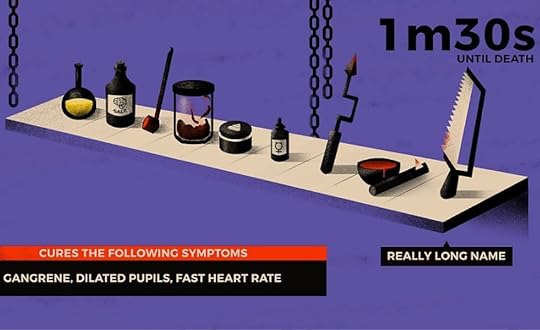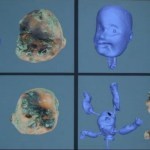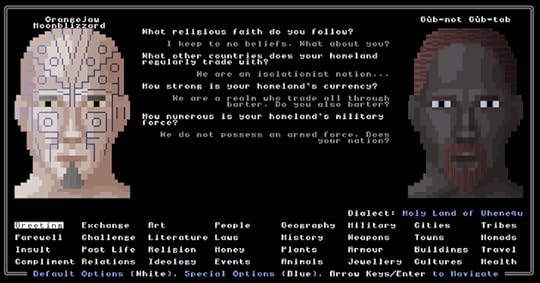Kill Screen Magazine's Blog, page 60
September 8, 2016
Thank you, Ultima Ratio Regum, for making RPG dialogue less boring
Ultima Ratio Regum, Mark Johnson’s epic 10-year roguelike project, aims to do a lot of things, but first and foremost it aims to reinvent how we approach procedural generation in lore-heavy games. The traditional view of algorithm-based writing is that it hits roadblocks between expansive possibilities and convincing humanity. Though you can program a game to offer hundreds of different choices, many will inevitably end up sounding similar. It leads to criticisms of procedural generation as “soulless,” and many doubt that computers will ever be able to create realistic humanity in such a significant manner.
differ speech without ignoring the small idiosyncrasies of humanity
But Johnson’s experiments with Ultima Ratio Regum have taken leaps and bounds to remedy that. In the years that he’s already spent working on the game he’s dissected language to its essential components and dedicated hours to figuring out ways to differ speech; keeping it compelling without ignoring the small idiosyncrasies that mark all human beings. He has created systems that account for dialect, isolation, cultural biases, religious influence, and more.
For example, Johnson has split dialog into four distinct influences: sentence complexity, education, patience, and privacy. In addition to evaluating what information a character will know, these affect how long their sentences will be, what word choice they will use, how long they can tolerate pointless questions, etc. It attempts to combat the repetitive clicking of most RPG conversations. In Ultima Ratio Regum, a guard won’t be willing to sit through six instances of asking where the prison cells are, a beggar isn’t going to respond to your brief greeting in flowery language, and characters may choose not to disclose information that they already know.
But Johnson’s isn’t the first one to experiment like this. For every innovation that he’s made, another exists unnoticed, draped in a genre too preoccupied to acknowledge its boldness. Yes, procedural generation is a first, but games have always tried to layer exception upon exception. A gender bias layered upon a racial bias layered upon a class bias provides just as tailor-made writing as procedural generation could—language was dissected into these parts long before Johnson came along. But to combine them is an ambitious goal: for humanity to not just be written, but be created, by something digital is still a theoretical idea.
It makes sense that, once broken down into sufficiently small parts, humanity could be replicated by a computer. The irrationalities of culture, dialect, and superstition can be approximated. Ultima Ratio Regum only seeks to prove their version of humanity is possible.
Johnson’s comprehensive devlog can be found on his website .
The post Thank you, Ultima Ratio Regum, for making RPG dialogue less boring appeared first on Kill Screen.
After nearly a decade of waiting, Owlboy will leave the nest this November
After nearly 10 years of work, D-Pad Studio recently announced at PAX West that its action-platformer Owlboy is releasing on November 1.
Owlboy began life back in 2007 as an attempt by pixel artist Simon Andersen to show that 2D could still be better than 3D, and it quickly gathered the attention of other artists, who ultimately joined Andersen’s team. Six years ago, it was nominated for an Excellence in Visual Art award at the Independent Games Festival and it won the Nordic Indie Sensation award at the Nordic Game Awards. After taking time off to work on the game Savant: Ascent (2013), D-Pad returned to Owlboy to finish nearly a decade’s worth of work—the final lap of a very long race.
struggling to live up to the expectations of being an owl
Players assume the role of a mute boy named Otus in Owlboy, who is struggling to live up to the expectations of being an owl. When unexpected pirates invade his world, he must travel through monster-filled ruins, facing “burdens no one should have to bear.” Luckily, to help him along, Otus has a bunch of friends he can pick up with his feet and carry around. As Otus has no means to attack enemies himself, he uses his agility to keep himself and his friends safe as they pick off whatever obstacles get in the way.
Owlboy will be available for PC digitally on Steam and GOG. D-Pad also announced a boxed version of the game, coming with its soundtrack, dual cover artwork, and an exclusive art print.
For more on Owlboy, read our conversation with D-Pad Studio about its game and its development. You can also follow the developer on Twitter for updates.
The post After nearly a decade of waiting, Owlboy will leave the nest this November appeared first on Kill Screen.
Apple and Nintendo sitting in a tree …
While the iPhone 7 was the star birthday boy of Apple’s keynote yesterday, there was a shocking amount of news from a once-rival company, Nintendo. To the amazement of everyone tuning in, there was apparently a Snorlax on stage, as seen during the demonstration of Pokemon Go on the Apple Watch. Those presenters were miraculously spared a trampled death.
Also worth mentioning is that videogame godfather Shigeru Miyamoto made a surprise appearance for a few hot minutes, consummating the romance that has been blossoming between his company and the omnipotent tech giant over the year. “For the past 30 years, every time Mario has encountered a new platform he has evolved and continued running towards a new goal,” said Miyamoto on stage. “And now, Mario is running towards his next goal, iPhone.”
it isn’t the sexiest game in the world
Miyamoto introduced Super Mario Run, Nintendo’s flagship Italian starring in his first mobile adventure. Looking similar to an endless runner, Super Mario Run is spun out of the New Super Mario Bros games, complete with wall jumping, Goomba stomping, and fun house environments. Like most runners, it isn’t the sexiest game in the world, but Nintendo appears to be treating it with some novel ideas on how to make coin collecting and navigating the space more of a challenge than something to merely busy your free hand. And, like most runners, you’ll probably just end up playing it anyway. The promise that the game will have a set price, instead of depending on microtransactions, is merciful as well.
It’s not the first time Mario has appeared on another company’s hardware, but it is a big advancement in the relationship between Nintendo and Apple. Nintendo held out from mobile games for a while, even as mobile games like Puzzle & Dragons dominated Japan, spelling out an obvious future. They didn’t jump into the hardware with much enthusiasm, either. Their first major release on the iPhone, Miitomo, seemed like a social media app made by someone who hates social media apps. A lot of gags, a lot of microtransactions, and nearly zero functionality. It was the kind of soft satire Nintendo seems to produce when they’re forced to be a follower instead of an innovator in the industry. Hands and feet, all limp and dragged along the ground. That all changed with a little overlooked game that no one has ever talked about, Pokemon Go.
If Nintendo’s heart wasn’t in the game, Pokemon Go clearly won them over. A game consumed with Beatlemania frenzy, it’s hard to imagine Nintendo wasn’t convinced of the potential a partnership with Apple could produce. And now they’re out and about. Holding hands. Drinking one malt with two straws. Ahh, that summer love.
Super Mario Run is slated for a December release. The only other major game announcement from the keynote was a demonstration of Oz: Broken Kingdom, a fantasy RPG to display the fidelity of the upcoming iPhone 7, though no mention of how hot that fucker got in the presenter’s hand. Broken Kingdom is being made by This Game Studio, who are not ThatGameCompany, nor ThoseGameStudios.
The post Apple and Nintendo sitting in a tree … appeared first on Kill Screen.
12 Things You Can Do While Playing Super Mario Run
multitask
[ muhl -tee-task, -tahsk, muhl -tahy-]
1: (of one person) to perform two or more tasks simultaneously.
We’re all busy people. And being busy, we have to multitask. For instance, imagine me commuting somewhere (a rarity—working from home and all), listening to a podcast, and styling my adorable Mii with dumb clothes in Miitomo (just kidding—no one plays that anymore), all simultaneously. “Where are my one-handed games?” I recently asked myself, and from the distant country of Japan, Shigeru Miyamoto heard. He channeled his inner Mario, and platformed his way to the Apple keynote stage to announce a surprise game to solve our multitasking gaming needs: a thankfully-not-free-to-play runner called Super Mario Run.
Eat a burger while playing Super Mario Run
Introducing this incredibly novel, fresh idea of one-handed playing is nothing short of genius from the man who brought us Mario, The Legend of Zelda, Star Fox, and Pikmin. As he stood proudly on Apple’s stage, Miyamoto listed a number of things players can do alongside Super Mario Run, including eating a burger, holding onto a handle on the subway, and chomping down on an apple. Miyamoto presented this triforce-like power of one-handed activities (bless his heart) where we might find ourselves bored out of our minds, and thirsting for that accessible Mario experience. I know I often find myself bored, and wondering what to do with a spare hand.
But Miyamoto had some glaring omissions. Luckily, your resident prolific multitasker Caty McCarthy (hey, that’s me) is around to fill in the negligent gaps in Miyamoto’s pitch. You’re welcome! No need to thank me. Anyways, here are 12 things that you can do while bouncing Goombas to death and collecting coins in Super Mario Run.
 Unclench that fist and maybe you’d have a chance.
Unclench that fist and maybe you’d have a chance.1. Drink a coffee. Because believe me, you need the energy to get through the day. And to collect those coins.
2. Play a round of Overwatch and lose! You’re playing with one hand, silly. You can’t help your team hindered like that, even if you are just a Torbjörn.
3. Prick your hand on the cactus on your desk. I do this accidentally while reaching for things all the time. Why not do it intentionally? Build up calluses for that extra hand, buddy.
4. Check on your Pokémon Go account from your expensive Apple Watch. You make six-figures a year and can afford a piece of needless wrist-tech that will be obsolete in a couple years, right?
5. Fish for those wireless Apple EarPods that slid behind your desk. Where did they go? How will you listen to the sweet sounds of Super Mario Run now? No one knows, except for the dust on your dirty floor that has consumed them, never to be found again.
6. Enthusiastically finger point in the air along to a song you’re listening to. If you’re at a concert, all the better! Just make sure your eyes don’t leave that Super Mario Run screen, bud. Precious mushrooms are at stake.
7. Make a level in Super Mario Maker. Throw in some springs to make it like a runner. Voila! You just re-invented Super Mario Run.
8. The obvious one-handed spare time activity. Just wash your hands before and after, please.
9. Sacrifice a lamb.
10. Play rock paper scissors. (Special thanks to Josh Calixto for this suggestion, and the one below, sorta.)
11. Squeeze a stressball, because your high scores in Super Mario Run are terrible. You’re ashamed of yourself. You’re breaking out in intense stress eczema, like that guy from The Night Of. The stressball lessens this pain. If your hand grows free for a moment, feel free to wipe away those tears. Just make sure no one sees.
12. Uh, play Super Mario Run in your other hand too! Use your significant other’s phone, or a friend’s, or your iPad. Or just imagine it, I guess. Or play another, probably better Mario game. That’s an option too.
 I got two phones, one for Super Mario Run and one for Super Mario Run.
I got two phones, one for Super Mario Run and one for Super Mario Run.Gear up to sprint across the Mushroom Kingdom when Super Mario Run is out this December for iOS (and Android at a later date), long before whatever Animal Crossing and Fire Emblem’s apps end up being. I hope none of them are a disaster. I will probably spend money on them all, regardless.
The post 12 Things You Can Do While Playing Super Mario Run appeared first on Kill Screen.
Obduction is not to be missed
Obduction, despite how cosmic the word sounds, does not refer to flying saucers. More terrestrial than extraterrestrial, obduction means when one oceanic tectonic plate heaves up and laps over a continental plate. One world eclipsing another. Imagine the confusion you’d feel if you one day woke up underwater.
Myst (1993) began with Atrus (one of the series’ central curators, played by co-creator Rand Miller) falling out of his world. An iconic frame—prime enough for the box art—of a free-fall silhouette descending from a rift into a starry unknown. In a similar setup, Obduction begins with the world falling on to you. A tranquil moonlight night by the lake, interrupted by a fallen star that explodes into a pollen of light. You awaken in the new world, or perhaps the town that is a world, Hunrath, abandoned and still. The train tracks, lone ranch house, and wild west village make it look like The Magic Kingdom’s eclectic and uninhabited ToonTown. The junkyard, graffiti, and power plant make it look like infrastructure hidden an hour’s drive from the city. The purple alien landscape, in the foreboding distance and surrounding everything, recontextualizes it all as a mystery. It’s all begging to be deciphered.
Cyan, creators of Myst, revealed the Kickstarter for Obduction on the anniversary of their original classic. There’s no mincing the tethers between the two. The faithful who wanted Myst or something like it can take a big sigh of relief.
In many broad sweeps you could describe both games in similar terms. The forests, libraries, and observatories; the environments and architecture of Myst only look confusing in proximity to each other. The bulk of storytelling is hidden in plain sight, scrawled on notes and in books left behind by whoever vanished in a rush. Obduction, too, has a generous number of live-action performers who pop in from holograms and windows like the queuing area at the Universal Studios theme park ride Kongfrontation. You’ll be pulling a ton of levers.
Its logic is based on Cyan’s new holistic sense of semiotics. It’s not that the world is designed to be challenging to its inhabitants, merely difficult to a layman. It would be the same to travel to a country with a different alphabet. High genre, such as fantasy and sci-fi, allows for tourism as a puzzle. Obduction gets this, it captures the challenge of getting lost, which can feel sweet the moment it stops feeling frustrating.
Obduction is completing that thought, or it aspires to challenge its plasticity. Hunrath is strange and faraway, but it’s 75 percent pedestrian: the refuge of abductees and the slices of America pilfered along with them throughout time; buildings filled with bean cans and books. The tools, phone booths, carts, and gas pumps, are ones you’ve used before. But imagine, if you will, in a Twilight Zone sense, that just one thing was out of place. The phone book was in a strange language, the paths lead in a circle, you look at the clock and things don’t add up, or the source of power for all your domestic appliances came from an alien source. Familiar objects in a strange world. The only goal the game spells out to you, through Hunrath’s last living soul C.W., is to escape. It sounded easy enough. At least when he said it.
essentially mapping an Escher painting
After an early hallmark, the last moment when things seem routinely manageable, you’ll discover just how distorted the geography of Hunrath truly is. The edges the of the bubble warp you to other parts of the periphery, and pods will outright teleport you to completely different environments. A lot of the challenge of Obduction is essentially mapping an Escher painting. Fitting together pieces of an unruly puzzle, tearing your hair out at times just to get over a wall can feel humbling. It might also be humiliating depending on much backtracking you do. It’s at these times that Obduction requires you to sharpen your smarts enough to overcome the process of trial and error. Yes, it can prove rewarding, but it also veers towards exhausting.
Despite outright dealing with alien dimensions that overlap in certain ways, Obduction’s puzzles don’t feel nearly as quantum as The Witness’s. They’re more about how you weave through the space than getting you stumped on a specific lock. However, those who found The Witness’ aesthetics needlessly cerebral, or prefer puzzles that feel more tactile, manual, will appreciate Obduction’s comparative frankness. I’m not saying Obduction is inherently easier, but I am saying that the solution is often something you’ve overlooked.
Obduction is one of the sharpest-looking Kickstarter babies to date. That’s also my veiled warning that, despite it being a puzzle game, you should be prepared with some decent PC hardware. It’s got vast and detailed environments. It’s all sharply coordinated with a great sense of flow. The big carrot is to create your own cohesive image of the abandoned world, to get real big geeky about the lore, something fans of Myst always seemed to appreciate.
With Obduction, Cyan has created another game that’s an art of personal journaling. What you know, what you’ve gathered, will save you. The tools seem familiar but it is details that are your weapons. As the otherworldly overlaps the banal, you’re trapped in a labyrinth of places and things.
For more about Kill Screen’s ratings system and review policy, click here.
The post Obduction is not to be missed appeared first on Kill Screen.
Bound brings videogames to the ballet
Sign up to receive each week’s Playlist e-mail here!
Also check out our full, interactive Playlist section.
Bound (PlayStation 4)
BY PLASTIC STUDIOS & SIE SANTA MONICA STUDIO
Rhythm games may use dancing animations to show a beat, but not many games engage with dance as an artform. In Bound, the beauty of the ballet takes center stage. The platformer casts the player as a faceless dancer who must defeat a nebulous monster by pirouetting across each fragmented level. With abstract landscapes and an irresistibly graceful protagonist, Bound is a feast for the eyes. The surreal story and level design paint an allusive picture, but the incredible performance by dancer Maria Udod (and choreographer Michal Adam Góral) ground the game in a tactile elegance.
Perfect for: Dancers, ballet snobs, surrealists
Playtime: 2 hours
The post Bound brings videogames to the ballet appeared first on Kill Screen.
September 7, 2016
The Fall Part 2 promises to plummet further into its AI nightmare
We were exposed to the first part of the sci-fi videogame trilogy The Fall over two years ago now. It’s about time some more info on the second part arrived—and that it has, and with a trailer to boot. You can expect it to arrive during first quarter of 2017 on PlayStation 4, Xbox One, Wii U, Windows, Mac, and Linux.
The Fall Part 2: Unbound, as it’s called, will continue the journey of ARID, the AI onboard a high-tech combat suit that players will control. The trailer for The Fall Part 2 picks up right where the first game left off, with ARID laying on the ground, left with a single note—“You have to fall to pick yourself back up.”
the team promises more “weird shit”
That quotation may be a bit of an obvious allusion to the game’s title but there’s a little more to it than that. The Fall Trilogy focuses on the feeling of falling. This could mean any number of things, from literally falling into space to reaching the rock bottom of life, where the protagonist squanders until they, yes, pick themselves back up. This is a common trope in film, from pure dramas like Requiem for a Dream (2000) to comedies like Anchorman (2004). Throw in some AI elements like Ex Machina (2015) that already seem like they’re part of our reality and you have the feeling portrayed in The Fall Trilogy. It’s all about forcing your character to get back up when they’re down, even when that seems like the wrong choice to make.
Besides the assumptions that ARID is safe (for now), the team at Over The Moon Games has said that their primary goal with The Fall Part 2 is to “kick [their] story integration game up a level or two” to hopefully make every move players make meaningful. On top of that, they will be answering directly to critics who claimed the controls of Part One were a bit too difficult with a revamped control scheme. The idea is to have the controls more closely mimic inspirations such as Super Metroid (1994) and Castlevania: Circle of the Moon (2001). It’s said there will also be plenty of point-and-click puzzles similar to games like Grim Fandango (1998). Finally, the team promises more “weird shit,” which is right up our alley. How can you not love pondering what that means?!
You can find out more about The Fall over on the creator’s website.
The post The Fall Part 2 promises to plummet further into its AI nightmare appeared first on Kill Screen.
Die-Agnosis turns the terrifying history of medical treatment into comedy
Being a doctor in olden times wasn’t an easy task. With no antiseptics, antibiotics, or anesthesia, caring for patients even now wouldn’t be an easy task. You can throw on top of that constant plagues and, oh yeah, replace all modern medical knowledge with cures such as peeing into someone’s ear to relieve their earache. The only thing worse than being an ancient doctor is needing an ancient doctor. Die-Agnosis puts you in the shoes of one of these thoroughly misguided doctors, just doing their best to help the ill.
“My sore is oozing”
Die-Agnosis was created for Ludum Dare 36 and its theme of ancient technology—a theme it gleefully delivers on. Although such a short game couldn’t possibly capture the wide variety of bizarreness in ancient medicine, it does give a wonderful snapshot. “My sore is oozing,” complains your patient, so you supply some urine. “Aaah!” cries your patient, gesturing to their fractured bone, which you fix with mercury (somehow). Other ailments may require a more delicate touch—like a hole drilled into the head, or a sawed off limb. If all else fails, you can give them opium, which will at least make them unaware of whatever problem they have.

Die-Agnosis is delightfully grim. From the sickly green light of the home you work in, to the maggots worming in your patient’s skin, Die-Agnosis captures a time and profession that was dark and grotesque. Sometimes the game isn’t responsive to treatments, and it’s not clear if this is because it was the wrong treatment, or if it’s the game glitching. But, in truth, this only feels more realistic.
Did the leeches work? Who knows, let’s try some brain salt! Although we may smirk at the dark humor of rubbing dung over oneself to fix a rash, we also should thank our lucky stars to live in an era with dermatologists. The creators of the game, We Fiends, nail black humor on the head, but if you’ve got issues with body horror, you might want to stay away from this one.
Download and play Die-Agnosis right here.
The post Die-Agnosis turns the terrifying history of medical treatment into comedy appeared first on Kill Screen.
How Resident Evil 7’s grossest monsters are made
Resident Evil 7 looks really gross. But, judging by the amount of work going into it, that may be the best compliment it can be given.
Speaking at the 2016 Computer Entertainment Developers Conference, people from Capcom working on Resident Evil 7 showed off some of the ways they’re using photogrammetry to create in-game assets including clothing, environments, characters, and, most interestingly, monsters and wounds. As reported by IGN Japan and Famitsu (translation via NeoGAF), numerous models were shown side-by-side with their in-game counterparts.
capturing the mood of “various creepy areas” in Japan
Photogrammetry works, put simply, by taking pictures of an object in quick succession, then rebuilding it in 3D. This technique is often used, as is also the case for Resident Evil 7, to create highly detailed, lifelike assets at a quicker rate than being completely created by hand by designers. According to Capcom’s team, more than half of the game’s assets were created using photogrammetry.

The creators actually did a lot of on-location shooting, capturing the mood of “various creepy areas” in Japan. One such location was the Japanese city Nara, where shots of gardens, lanterns, and deer head were taken.
For certain monsters and character models, the game makers created their own highly-detailed rigs out of clay and other materials to photograph. In the case of one particular monster, Capcom went to a meat processing plant to take photographs of different meats, creating a creature comprised almost entirely of different dead animals.
Resident Evil 7 is expected to release on January 27, 2017 for PlayStation 4, Xbox One, and PC.





///
Images via Famitsu
The post How Resident Evil 7’s grossest monsters are made appeared first on Kill Screen.
A videogame tribute to 1930s cartoons you can play right now
Grandpa has a big date but his house is a mess. The bed is unmade. Dinner is uncooked. Junk mail is strewn about. With only a minute to spare, can he whip the house in shape before his date arrives?
Grampy Katz in: The Big Date is a short but adorable game made by Brent “Meowza” Kobayashi and Brandi “Kukubee” Kobayashi. The married duo created the game in under 72 hours as part of the recent Ludum Dare game jam. “I wanted to make a game about an old person for a little while now because there aren’t a lot of games about [them],” said Brent. Ludum Dare, with its theme of “Ancient Technologies”, seemed like a perfect place to explore this.
the possibilities of making games that looked like cartoons
Inspired by their love of bite-sized silly games like Overcooked and Tenya Wanya Teens (2013), Brent and Brandi settled on their own silly game about an old man preparing for a date. “We’re sort of romantics at heart so that seemed like a cute idea to us,” explained Brent. This idea morphed into Grampy Katz where you take control of the titular character as he frantically dashes from one end of the room to the other while trying to finish all his chores in time.
What’s delightful to see among all this frenzy is the game’s old-timey vibe. As self-confessed cartoon buffs, the Kobayashis drew visual inspiration from 1930s cartoons like Mickey Mouse in Steamboat Willie and in Oswald the Lucky Rabbit. Another major inspiration was the upcoming game Cuphead as it showed them the possibilities of making games that looked like cartoons. Drawing from all these influences, Grampy Katz evokes a similar sense of mischievousness from the way the soundtrack syncs with the game’s frenetic pace (otherwise known as “mickey mousing”) to the way the characters bobble and move.
“I think [the game comes from] our love of old-school cartoons. It seems like back then, people made them just because they could,” said Brent. “We wanted to bring that same kind of spirit to games as well and just make people smile.”
To play Grampy Katz for yourself, head over to itch.io . The Kobayashis plan on further expanding the game with hopes of bringing it to iOS and Android. Follow the game’s progress on Twitter ( @meowza or @kukubee ).
The post A videogame tribute to 1930s cartoons you can play right now appeared first on Kill Screen.
Kill Screen Magazine's Blog
- Kill Screen Magazine's profile
- 4 followers











